On 17 July 2015, a member of the Parliamentary Minority, Zurab Japaridze, stated that practically every economic indicator has worsened in Georgia in 2015.
FactCheck took interest in the accuracy of the statement.
The following comprise principal economic indicators:
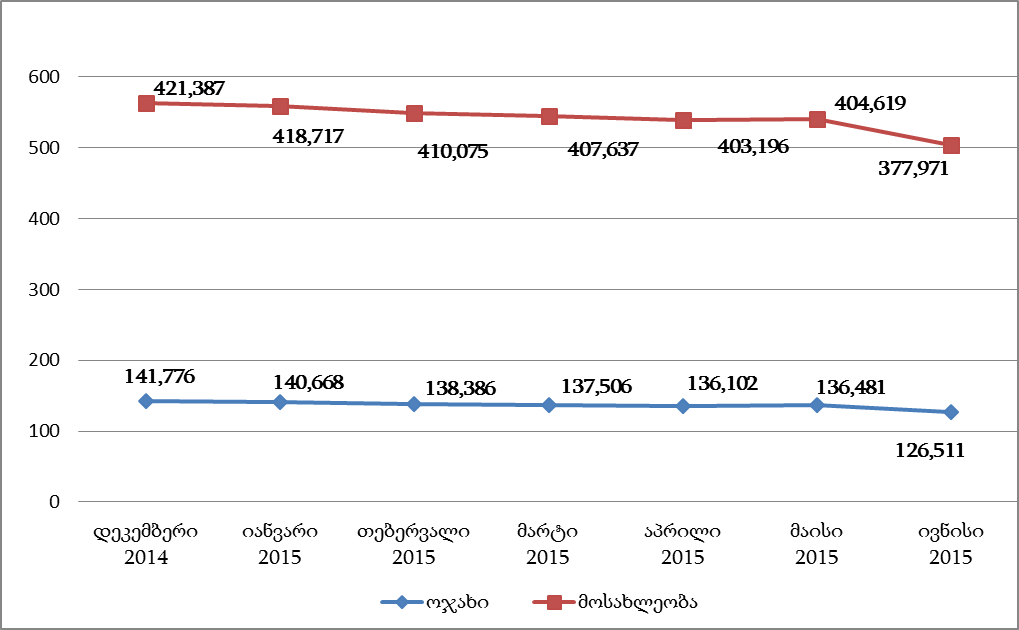 Source: National Statistics Office of Georgia
The indicators of trade also worsened over the course of 2015. The volume of import for the first six months decreased by 8.8% as compared to the import volume of the first six months of 2014.
Graph 2: Georgia’s Import – The First Six Months of 2015 (USD thousand)
Source: National Statistics Office of Georgia
The indicators of trade also worsened over the course of 2015. The volume of import for the first six months decreased by 8.8% as compared to the import volume of the first six months of 2014.
Graph 2: Georgia’s Import – The First Six Months of 2015 (USD thousand)
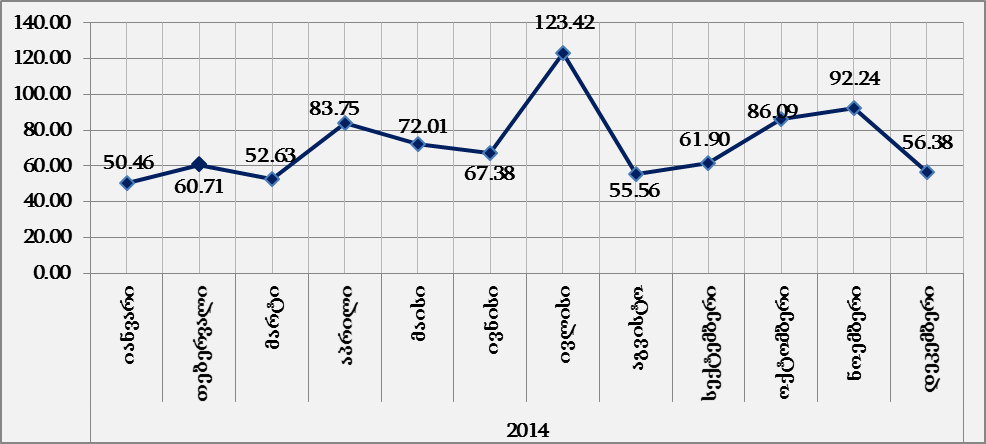 Source: National Statistics Office of Georgia
The volume of export has decreased even further. In the first six months of 2015, Georgia registered a 24% decline in exports.
Graph 3: Georgia’s Export – The First Six Months of 2014-2015 (USD thousand)
Source: National Statistics Office of Georgia
The volume of export has decreased even further. In the first six months of 2015, Georgia registered a 24% decline in exports.
Graph 3: Georgia’s Export – The First Six Months of 2014-2015 (USD thousand)
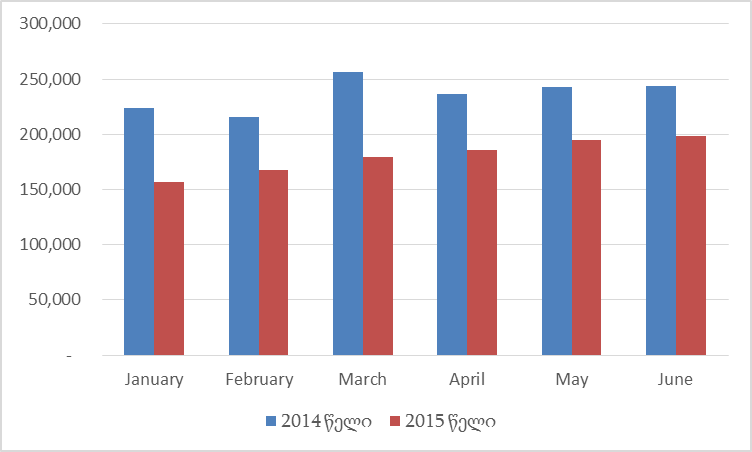 Source: National Statistics Office of Georgia
The volume of foreign direct investments (FDI) needs to be mentioned among the list of economic indicators. After 2012, foreign direct investments exhibited an upward trend. However, in the first quarter of 2015 the volume of FDI decreased as compared to the first quarter of 2014 and hit the last five years’ minimum.
Graph 4: Foreign Direct Investments in 2004-2015 (USD million)
Source: National Statistics Office of Georgia
The volume of foreign direct investments (FDI) needs to be mentioned among the list of economic indicators. After 2012, foreign direct investments exhibited an upward trend. However, in the first quarter of 2015 the volume of FDI decreased as compared to the first quarter of 2014 and hit the last five years’ minimum.
Graph 4: Foreign Direct Investments in 2004-2015 (USD million)
 Source: National Statistics Office of Georgia
In November 2014, GEL started to depreciate against USD. In the course of the last eight months GEL has dropped by 27% against USD.
Graph 5: GEL – USD Exchange Rate
Source: National Statistics Office of Georgia
In November 2014, GEL started to depreciate against USD. In the course of the last eight months GEL has dropped by 27% against USD.
Graph 5: GEL – USD Exchange Rate
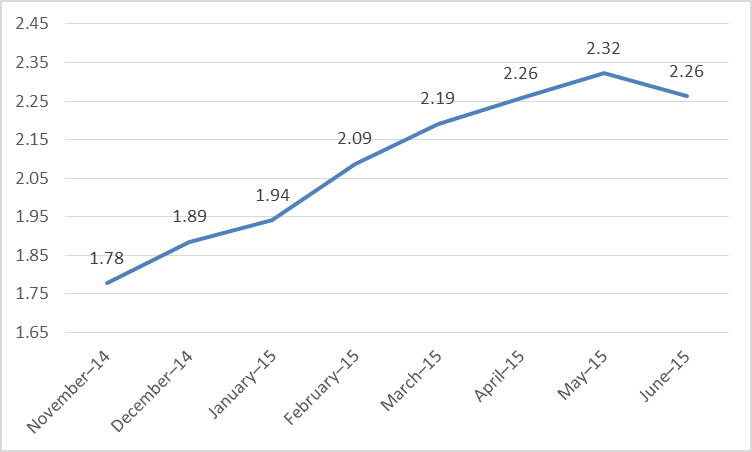 Source: National Bank of Georgia
The rate of inflation has also increased during the last few years. The rate of inflation was 2% in 2011 and 1.4% in 2012 whilst in the course of the last three years the rate of inflation has grown and reached 4.5% in 2015.
Graph 6: Inflation Rate in 2004-2015 (as compared to the same months of the previous years)
Source: National Bank of Georgia
The rate of inflation has also increased during the last few years. The rate of inflation was 2% in 2011 and 1.4% in 2012 whilst in the course of the last three years the rate of inflation has grown and reached 4.5% in 2015.
Graph 6: Inflation Rate in 2004-2015 (as compared to the same months of the previous years)
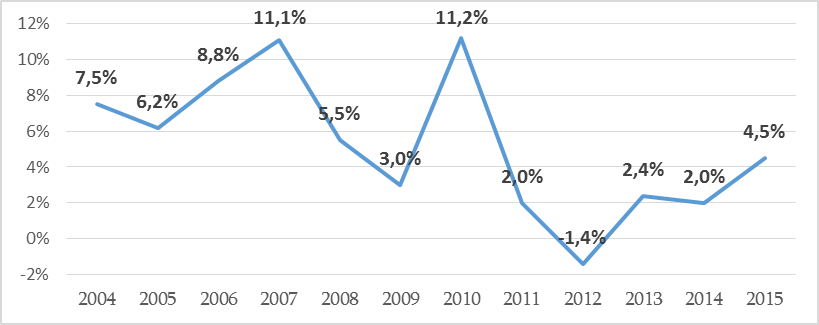 Source: National Statistics Office of Georgia
According to the official statistical data, the rate of unemployment, which is also an integral component of the list of basic economic indicators, decreased. In 2014, the rate of unemployment decreased by 2.2% as compared to the previous year and stands at 12.4%.
Graph 7: Unemployment In Georgia In 2004-2015
Source: National Statistics Office of Georgia
According to the official statistical data, the rate of unemployment, which is also an integral component of the list of basic economic indicators, decreased. In 2014, the rate of unemployment decreased by 2.2% as compared to the previous year and stands at 12.4%.
Graph 7: Unemployment In Georgia In 2004-2015
 Source: National Statistics Office of Georgia
In the period of 2004-2007, Georgia’s national debt was decreasing. However, after 2007, the country’s national debt has been growing annually. Additionally, the debt-to-GDP ratio is an important indicator to take into consideration when discussing the national debt. In 2013-2014, Georgia’s debt-to-GDP ratio increased from 35% to 36%. In 2015, due to the depreciation of GEL, the national debt increased substantially. As of June 2015, Georgia’s national debt is GEL 11.6 billion which constitutes a 19.1% growth as compared to June 2014. The debt-to-GDP ratio is now at 41%.
Graph 8: National Debt (USD thousand) and Debt-to-GDP Ratio in 2004-2015
Source: National Statistics Office of Georgia
In the period of 2004-2007, Georgia’s national debt was decreasing. However, after 2007, the country’s national debt has been growing annually. Additionally, the debt-to-GDP ratio is an important indicator to take into consideration when discussing the national debt. In 2013-2014, Georgia’s debt-to-GDP ratio increased from 35% to 36%. In 2015, due to the depreciation of GEL, the national debt increased substantially. As of June 2015, Georgia’s national debt is GEL 11.6 billion which constitutes a 19.1% growth as compared to June 2014. The debt-to-GDP ratio is now at 41%.
Graph 8: National Debt (USD thousand) and Debt-to-GDP Ratio in 2004-2015
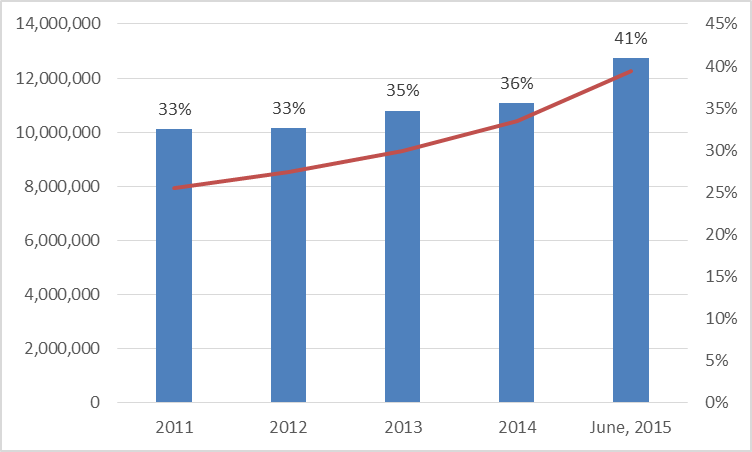 Source: Ministry of Finance of Georgia
Conclusion
Basic economic indicators include the GDP growth rate, foreign trade, foreign direct investments, the currency exchange rate, the inflation rate, the unemployment rate and the national debt.
In 2014-2015, the basic economic indicators worsened for the most part. Georgia’s economic growth rate decreased alongside export and import. Additionally, foreign direct investments also dropped in the first quarter of 2015.
Since November 2014 until July 2015, GEL depreciated against USD by 27%. The inflation rate also rose and at the end of June 2015 it was 4.5% higher than it was in June 2014.
The nominal amount of the national debt increased by 19.1% in June 2015 as compared to 31 December 2014 and reached GEL 11.6 billion. The debt-to-GDP ratio also increased. In 2014, it rose from 35% to 36% whilst as of June 2015 the debt-to-GDP ratio stood at 41%.
The unemployment rate is the only economic indicator which improved according to official statistics. In 2014, the unemployment rate decreased from 14.6% to 12.4%.
Considering all of the aforementioned information, Zurab Japaridze’s statement is MOSTLY TRUE.
Source: Ministry of Finance of Georgia
Conclusion
Basic economic indicators include the GDP growth rate, foreign trade, foreign direct investments, the currency exchange rate, the inflation rate, the unemployment rate and the national debt.
In 2014-2015, the basic economic indicators worsened for the most part. Georgia’s economic growth rate decreased alongside export and import. Additionally, foreign direct investments also dropped in the first quarter of 2015.
Since November 2014 until July 2015, GEL depreciated against USD by 27%. The inflation rate also rose and at the end of June 2015 it was 4.5% higher than it was in June 2014.
The nominal amount of the national debt increased by 19.1% in June 2015 as compared to 31 December 2014 and reached GEL 11.6 billion. The debt-to-GDP ratio also increased. In 2014, it rose from 35% to 36% whilst as of June 2015 the debt-to-GDP ratio stood at 41%.
The unemployment rate is the only economic indicator which improved according to official statistics. In 2014, the unemployment rate decreased from 14.6% to 12.4%.
Considering all of the aforementioned information, Zurab Japaridze’s statement is MOSTLY TRUE.
- GDP Growth Rate;
- Foreign Trade (external and internal);
- Foreign Direct Investments;
- Currency Exchange Rate;
- Inflation Rate;
- Unemployment;
- National Debt.
 Source: National Statistics Office of Georgia
The indicators of trade also worsened over the course of 2015. The volume of import for the first six months decreased by 8.8% as compared to the import volume of the first six months of 2014.
Graph 2: Georgia’s Import – The First Six Months of 2015 (USD thousand)
Source: National Statistics Office of Georgia
The indicators of trade also worsened over the course of 2015. The volume of import for the first six months decreased by 8.8% as compared to the import volume of the first six months of 2014.
Graph 2: Georgia’s Import – The First Six Months of 2015 (USD thousand)
 Source: National Statistics Office of Georgia
The volume of export has decreased even further. In the first six months of 2015, Georgia registered a 24% decline in exports.
Graph 3: Georgia’s Export – The First Six Months of 2014-2015 (USD thousand)
Source: National Statistics Office of Georgia
The volume of export has decreased even further. In the first six months of 2015, Georgia registered a 24% decline in exports.
Graph 3: Georgia’s Export – The First Six Months of 2014-2015 (USD thousand)
 Source: National Statistics Office of Georgia
The volume of foreign direct investments (FDI) needs to be mentioned among the list of economic indicators. After 2012, foreign direct investments exhibited an upward trend. However, in the first quarter of 2015 the volume of FDI decreased as compared to the first quarter of 2014 and hit the last five years’ minimum.
Graph 4: Foreign Direct Investments in 2004-2015 (USD million)
Source: National Statistics Office of Georgia
The volume of foreign direct investments (FDI) needs to be mentioned among the list of economic indicators. After 2012, foreign direct investments exhibited an upward trend. However, in the first quarter of 2015 the volume of FDI decreased as compared to the first quarter of 2014 and hit the last five years’ minimum.
Graph 4: Foreign Direct Investments in 2004-2015 (USD million)
 Source: National Statistics Office of Georgia
In November 2014, GEL started to depreciate against USD. In the course of the last eight months GEL has dropped by 27% against USD.
Graph 5: GEL – USD Exchange Rate
Source: National Statistics Office of Georgia
In November 2014, GEL started to depreciate against USD. In the course of the last eight months GEL has dropped by 27% against USD.
Graph 5: GEL – USD Exchange Rate
 Source: National Bank of Georgia
The rate of inflation has also increased during the last few years. The rate of inflation was 2% in 2011 and 1.4% in 2012 whilst in the course of the last three years the rate of inflation has grown and reached 4.5% in 2015.
Graph 6: Inflation Rate in 2004-2015 (as compared to the same months of the previous years)
Source: National Bank of Georgia
The rate of inflation has also increased during the last few years. The rate of inflation was 2% in 2011 and 1.4% in 2012 whilst in the course of the last three years the rate of inflation has grown and reached 4.5% in 2015.
Graph 6: Inflation Rate in 2004-2015 (as compared to the same months of the previous years)
 Source: National Statistics Office of Georgia
According to the official statistical data, the rate of unemployment, which is also an integral component of the list of basic economic indicators, decreased. In 2014, the rate of unemployment decreased by 2.2% as compared to the previous year and stands at 12.4%.
Graph 7: Unemployment In Georgia In 2004-2015
Source: National Statistics Office of Georgia
According to the official statistical data, the rate of unemployment, which is also an integral component of the list of basic economic indicators, decreased. In 2014, the rate of unemployment decreased by 2.2% as compared to the previous year and stands at 12.4%.
Graph 7: Unemployment In Georgia In 2004-2015
 Source: National Statistics Office of Georgia
In the period of 2004-2007, Georgia’s national debt was decreasing. However, after 2007, the country’s national debt has been growing annually. Additionally, the debt-to-GDP ratio is an important indicator to take into consideration when discussing the national debt. In 2013-2014, Georgia’s debt-to-GDP ratio increased from 35% to 36%. In 2015, due to the depreciation of GEL, the national debt increased substantially. As of June 2015, Georgia’s national debt is GEL 11.6 billion which constitutes a 19.1% growth as compared to June 2014. The debt-to-GDP ratio is now at 41%.
Graph 8: National Debt (USD thousand) and Debt-to-GDP Ratio in 2004-2015
Source: National Statistics Office of Georgia
In the period of 2004-2007, Georgia’s national debt was decreasing. However, after 2007, the country’s national debt has been growing annually. Additionally, the debt-to-GDP ratio is an important indicator to take into consideration when discussing the national debt. In 2013-2014, Georgia’s debt-to-GDP ratio increased from 35% to 36%. In 2015, due to the depreciation of GEL, the national debt increased substantially. As of June 2015, Georgia’s national debt is GEL 11.6 billion which constitutes a 19.1% growth as compared to June 2014. The debt-to-GDP ratio is now at 41%.
Graph 8: National Debt (USD thousand) and Debt-to-GDP Ratio in 2004-2015
 Source: Ministry of Finance of Georgia
Conclusion
Basic economic indicators include the GDP growth rate, foreign trade, foreign direct investments, the currency exchange rate, the inflation rate, the unemployment rate and the national debt.
In 2014-2015, the basic economic indicators worsened for the most part. Georgia’s economic growth rate decreased alongside export and import. Additionally, foreign direct investments also dropped in the first quarter of 2015.
Since November 2014 until July 2015, GEL depreciated against USD by 27%. The inflation rate also rose and at the end of June 2015 it was 4.5% higher than it was in June 2014.
The nominal amount of the national debt increased by 19.1% in June 2015 as compared to 31 December 2014 and reached GEL 11.6 billion. The debt-to-GDP ratio also increased. In 2014, it rose from 35% to 36% whilst as of June 2015 the debt-to-GDP ratio stood at 41%.
The unemployment rate is the only economic indicator which improved according to official statistics. In 2014, the unemployment rate decreased from 14.6% to 12.4%.
Considering all of the aforementioned information, Zurab Japaridze’s statement is MOSTLY TRUE.
Source: Ministry of Finance of Georgia
Conclusion
Basic economic indicators include the GDP growth rate, foreign trade, foreign direct investments, the currency exchange rate, the inflation rate, the unemployment rate and the national debt.
In 2014-2015, the basic economic indicators worsened for the most part. Georgia’s economic growth rate decreased alongside export and import. Additionally, foreign direct investments also dropped in the first quarter of 2015.
Since November 2014 until July 2015, GEL depreciated against USD by 27%. The inflation rate also rose and at the end of June 2015 it was 4.5% higher than it was in June 2014.
The nominal amount of the national debt increased by 19.1% in June 2015 as compared to 31 December 2014 and reached GEL 11.6 billion. The debt-to-GDP ratio also increased. In 2014, it rose from 35% to 36% whilst as of June 2015 the debt-to-GDP ratio stood at 41%.
The unemployment rate is the only economic indicator which improved according to official statistics. In 2014, the unemployment rate decreased from 14.6% to 12.4%.
Considering all of the aforementioned information, Zurab Japaridze’s statement is MOSTLY TRUE.
Tags:








